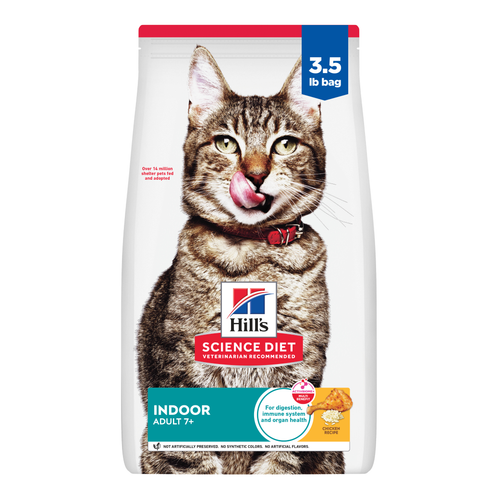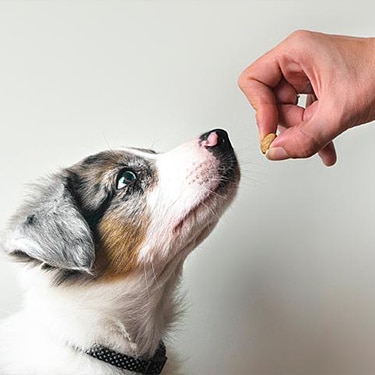
-
Find the right food for your petTake this quiz to see which food may be the best for your furry friend.Find the right food for your petTake this quiz to see which food may be the best for your furry friend.Featured products
 Adult Small Bites Chicken & Barley Recipe Dog Food
Adult Small Bites Chicken & Barley Recipe Dog FoodSupports lean muscle for dogs who prefer smaller kibble
Shop Now Adult Sensitive Stomach & Sensitive Skin Variety Pack Pouches (Chicken Stew & Turkey Stew)
Adult Sensitive Stomach & Sensitive Skin Variety Pack Pouches (Chicken Stew & Turkey Stew)Supports digestive health, nourishes skin and promotes a lustrous coat
Shop Now Adult 7+ Senior Vitality Chicken & Vegetable Stew Dog Food
Adult 7+ Senior Vitality Chicken & Vegetable Stew Dog FoodNutrition that helps a senior dog's everyday ability to get up and go
Shop NowFeatured products Adult 7+ Indoor Chicken Recipe Cat Food
Adult 7+ Indoor Chicken Recipe Cat FoodSupports energy level and beautiful fur in mature indoor cats
Shop Now Senior Vitality Adult 7+ Tuna & Vegetables Stew
Senior Vitality Adult 7+ Tuna & Vegetables StewImproves Everyday Ability to Get Up & Go
Shop Now Adult Turkey & Liver Entrée Cat Food
Adult Turkey & Liver Entrée Cat FoodPrecisely balanced nutrition with the delicious taste of minced turkey & liver to help fuel the energy needs of cats during the prime of their life
Shop Now -
Dog
- Dog Tips & Articles
-
Health Category
- Weight
- Food & Environmental Sensitivities
- Urinary
- Digestive
- Joint
- Kidney
-
Life Stage
- Puppy Nutrition
- Adult Nutrition
- Senior Nutrition
Cat- Cat Tips & Articles
-
Health Category
- Weight
- Skin & Food Sensitivities
- Urinary
- Digestive
- Kidney
-
Life Stage
- Kitten Nutrition
- Adult Nutrition
Featured articles The Science Behind Our Love for Pets
The Science Behind Our Love for PetsLearn the scientific reasons why we have such strong connections with our pets, and what science says about the love between humans and our furry friends.
Read More What Is Littermate Syndrome? Pet Adoption Guide
What Is Littermate Syndrome? Pet Adoption GuideLearn more about littermate syndrome in dogs and cats and how to successfully navigate adoption and early socialization processes.
Read More How to Properly Mix Wet & Dry Pet Foods
How to Properly Mix Wet & Dry Pet FoodsAn Orange cat eating from a bowl filled with mixed food
Read More -


Most humans have an innate fear of snakes, but if you've ever seen a dog encounter a serpent, you may have been surprised to see that they don't share our phobia. In fact, dogs have a playful curiosity that can quickly result in an unhappy dog bitten by a snake.
Learn more about some of the most common signs that your dog has been bitten and how to treat a snake bite on a dog if it does happen. Time plays a critical role in your dog's health should you ever find yourself in this situation.
Clinical Signs of a Dog Bitten by a Snake
It's simple enough if you actually see the bite, but snake bite symptoms can be tricky to discover in a furry dog. One of the most common sites that a snake bites is the dog's face. Signs often develop within 30 minutes of a bite, and a swollen muzzle is a telltale sign. Dual puncture wounds can be evidence of fangs, and they may ooze red or red-tinged liquid. Swelling is also common, and local discoloration may occur given enough time. If the bite was venomous, shock may set in, and it may present symptoms in the form of:
- Pale gums
- Mental dullness
- Exaggerated respiration
- Collapsing
- Tremors
- Slow breathing
- Excessive drooling
Rapid and progressive weakness can be a common and frightening thing for pet parents to witness.
One thing to remember: Snakes that are poisonous to people are not only poisonous to dogs (and cats) but are typically more dangerous because most pets have a much smaller body size than the average person.

Was Your Dog Bitten by a Snake? Here's What to Do
Snake envenomation can pose real danger. If you saw the snake bite your dog, you should take immediate action. While there is no way of knowing if envenomation has occurred after simply witnessing the bite, knowing which steps to take should your dog be bitten is vital:
- Remove your dog from the snake as quickly as possible. If the snake is still present, make sure to avoid getting bitten yourself.
- If you have your phone with you, try and take a picture of the snake to help the veterinarian identify the species, and in the case of a venomous snake, what type of venom it might have.
- Promptly carry the dog to the car and head to the veterinarian.
- Call the vet to let them know you're on your way. If you know the snake species already, share this information so that they can adequately prepare.
- Keep the bite site below heart level, if possible.
- Try to keep your pup, as well as yourself, calm. Our pets feed off our anxiety so keeping calm is essential.
Getting to the vet promptly is your number one concern. Try not to get distracted by taking on any first aid tactics. According to a peer-reviewed article in Clinical Techniques in Small Animal Medicine, first aid measures have not been shown to prevent morbidity or mortality following snake bites in dogs.
Diagnosing a Dog Bitten by a Snake
There are over 3,000 species of snakes worldwide, and over 600 of these are venomous, according to National Geographic. Vipers, pit vipers, rattlesnakes, sea snakes and coral snakes all pose a threat to dogs and humans alike. If you are unable to identify the snake species that bit your dog, your vet's expertise in assessing and treating your pup is even more important.
If you aren't sure what type of snake bit your dog, the vet will apply treatment based upon the observation of bite wounds and the presence of compatible clinical signs. There is no veterinary lab test to check for the presence of venom, but your vet will want to run lab work to determine the extent of any damage to the internal organs and blood cells.


Tasty Tips
How to Treat a Snake Bite on a Dog
Different bites may be treated with a combination of antihistamines and anti-inflammatory medications, antibiotics, anti-venom (when appropriate) and fluid therapy to counter potential hypotension or shock. Artificial ventilation may also be warranted if your dog's respiratory distress is not alleviated with medications.
Veterinary Clinics of North America: Small Animal Practice reports that although only 0.06% of people die following a snake bite, almost a third of dogs do. What makes a dog likely to survive? The site of the bite is important, as dogs with bites on limbs and tails tend to fare better than dogs with bites to the face or body. If the bite occurs on the face, the tongue or the throat, swelling is a serious side effect that can prove deadly if the airway becomes obstructed. Other factors that may influence survival include the dog's size and the time that lapses between the bite and veterinary intervention.
Preventing Dog Snake Bites
If you live in a region that has a known species of poisonous snakes, you may be particularly cautious to keep your dog from getting bitten by a snake. Here are some helpful tips to keep your dog from getting bitten:
- Don't let your dog dig or stick their head underneath rocks, trees or other places that snakes like to hide.
- Do not let them swim in grassy areas of water where water snake nests might exist.
- When walking your dog out in the wilderness, try your best to stay on trails and do not let your dog wander too far from your side. If you notice them trying to sniff at something, pay careful attention. Snakes tend to not attack unless they feel that they are in danger. A curious pup sniffing this strange creature could be seen as a threat.
- Also, keep in mind that snakes are cold-blooded creatures, which means that they regulate their body temperature with the environment around them. This could mean avoiding cool areas on hotter days or warm spots on cooler days.
- Consider using pet-safe snake repellent in your yard, especially if you live near a body of fresh water.
- Eliminate items that attract sources of food for snakes. For example, bird feeders may attract rodents that eat the fallen seeds. Pay attention to anything in your yard that might attract small animals like mice or rabbits.
- Snakes track their prey based on vibrations. Large amounts of vibration will scare them away. If you encounter a snake, try stomping loudly to scare them away. However, try not to get to close to avoid getting bitten yourself.
Should you notice that your dog is showing signs of a snake bite, remember to contact your veterinarian as soon as possible. Immediate action can save your dog's life.


Dr. Laci Schaible is a small animal veterinarian, veterinary journalist, and a thought leader in the industry. She received her Doctor of Veterinary Medicine from Texas A&M University and her Masters in Legal Studies from Wake Forest University.
Related products

Supports digestive health, nourishes skin and promotes a lustrous coat

Supports lean muscle for dogs who prefer smaller kibble

Nutrition that helps a senior dog's everyday ability to get up and go

Chicken & Rice Stew with great taste and precisely balanced nutrition to support 5 essential building blocks for lifelong health
Related articles

Wondering where can I buy a dog? Consider adoption and explore the pros and cons of adopting a dog from a breeder versus an animal shelter.

Discover how the field of dog science is giving us more and more insights into the inner workings of our furry best friends.

Learn how to help keep your dog's immune system in tip-top shape, including nutritional immune system support for dogs and other strategies.

Can puppies have treats? Explore best practices for giving your puppy treats to ensure you're doing so in the healthiest way possible.

Put your dog on a diet without them knowing
Our low calorie formula helps you control your dog's weight. It's packed with high-quality protein for building lean muscles, and made with purposeful ingredients for a flavorful, nutritious meal. Clinically proven antioxidants, Vitamin C+E, help promote a healthy immune system.
Put your dog on a diet without them knowing
Our low calorie formula helps you control your dog's weight. It's packed with high-quality protein for building lean muscles, and made with purposeful ingredients for a flavorful, nutritious meal. Clinically proven antioxidants, Vitamin C+E, help promote a healthy immune system.

